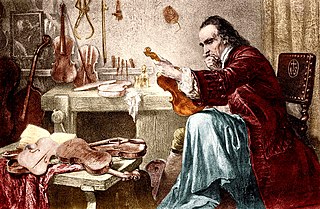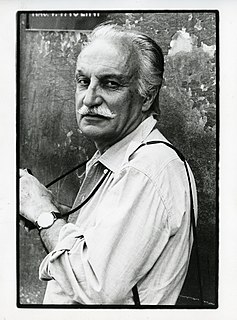
Antonio Stradivari was an Italian luthier and a craftsman of string instruments such as violins, cellos, guitars, violas and harps. The Latinized form of his surname, Stradivarius, as well as the colloquial Strad are terms often used to refer to his instruments. It is estimated that Stradivari produced 1,116 instruments, of which 960 were violins. Around 650 instruments survived, including 450 to 512 violins.

Giovanni Bottesini, was an Italian Romantic composer, conductor, and a double bass virtuoso.
A luthier is a craftsperson who builds and repairs string instruments that have a neck and a sound box. The word "luthier" is originally French and comes from the French word for lute. The term was originally used for makers of lutes, but it came to be used already in French for makers of most bowed and plucked stringed instruments such as members of the violin family and guitars. Luthiers, however, do not make harps or pianos; these require different skills and construction methods because their strings are secured to a frame.

Carlo Bergonzi was an Italian luthier and is the first and most noted member of the Bergonzi family, an illustrious group of luthiers from Cremona, Italy, a city with a rich tradition of stringed instrument makers. Today his instruments are highly valued for their workmanship and tone. Although he was historically assumed to have first apprenticed with Hieronymus Amati or Antonio Stradivari, he is now known to have been the student of Vincenzo Rugeri.
Testore is an Italian surname.

Carlo Giuseppe Testore was an Italian luthier, who worked in his later life in Milan.
The year 1665 in music involved some significant events.

Giovanni Grancino (1637–1709), son of Andrea Grancino, was one of the early Milanese luthiers, and may have worked with his brother, Francesco.
Francesco Rugeri, also known as Ruger, Rugier, Rugeri, Ruggeri, Ruggieri, Ruggerius, was the first of an important family of luthiers, the Casa Rugeri in Cremona, Italy. His instruments are masterfully constructed. His violins are inspired by Nicolò Amati's "Grand Amati" pattern. Francesco was the first to develop a smaller cello design, which has become the standard for modern cello dimensions. Today, Rugeri's instruments are nearly as renowned as Nicolò Amati's instruments.

The Galli-Bibiena family, or Galli da Bibiena, was a family of Italian artists of the 17th and 18th centuries, including:

Leandro Bisiach was an Italian violin maker, who was born in Casale Monferrato and died in 1945 at Venegono Superiore near Varese.

Carlo Antonio Tavella (1668–1738) was an Italian painter of the Baroque period, active mainly in Genoa.
Carlo Sacchi (1617–1706) was an Italian painter of the Baroque period.

Nicola Amati, Nicolò Amati or Nicolao Amati was an Italian Master Luthier from Cremona, Italy. Amati is one of the most well known luthier from the Casa Amati. Nicola was the teacher of illustrious Cremonese School luthiers such as Andrea Guarneri and Giovanni Battista Rogeri. While no clear documentation exists for being apprentices in his shop, Amati may have also apprenticed Antonio Stradivari, Francesco Rugeri, and Jacob Stainer as their work is heavily influenced by Amati.

Carlo Antonio Testore (1687–1765) was a Milanese luthier.
Giuseppe Besozzi was an Italian oboist. In the eighteenth century the Besozzi family produced several important oboists who worked in Turin, Naples, London, Paris and Dresden. Giuseppe's brothers Alessandro Besozzi and Paolo Girolamo Besozzi lived in Turin, and his sons Antonio Besozzi in Naples and Gaetano Besozzi in Paris and London. Antonio Besozzi's son Carlo Besozzi worked in Dresden and Gaetano's son Girolamo Besozzi, the grandfather of the composer Louis Désiré Besozzi, worked in Paris.

Paolo Monti was an Italian photographer, considered to be one of Italy's greatest. He is known for his architectural photography.

Pasquale Vinaccia was an Italian luthier, appointed instrument-maker for the Queen of Italy, and maternal grandfather to Carlo Munier. In 1835 he improved the mandolin, creating a version of the instrument that used steel wires for strings, known today as the "Neapolitan Mandolin." His use of steel strings has become the dominant way of stringing mandolins.

Giacomo Bisiach was an Italian luthier.











